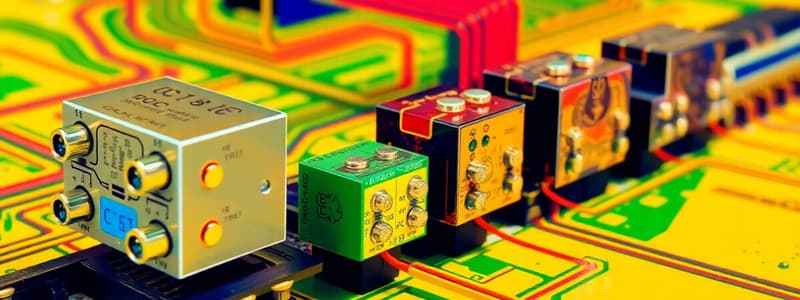Podcast
Questions and Answers
What is the minimum shunting value that must be maintained for track circuits?
What is the minimum shunting value that must be maintained for track circuits?
- 1.0 ohms
- 0.5 ohms (correct)
- 2.0 ohms
- 0.75 ohms
How often should the connection of DC track relays be interchanged?
How often should the connection of DC track relays be interchanged?
- Quarterly (correct)
- Biannually
- Monthly
- Yearly
Which component should be checked for dust during the visual inspection of track relays?
Which component should be checked for dust during the visual inspection of track relays?
- Armature
- Contact carriage
- Contacts (correct)
- Cover
What action should be taken if a defective track relay is discovered?
What action should be taken if a defective track relay is discovered?
What is the recommended lifespan for plug-in type track relays?
What is the recommended lifespan for plug-in type track relays?
Before replacing components in an insulated rail joint, what should be prepared ahead of time?
Before replacing components in an insulated rail joint, what should be prepared ahead of time?
What should be done if there is no gap at the insulated rail joint when replacing an end-post?
What should be done if there is no gap at the insulated rail joint when replacing an end-post?
Which of the following is NOT a visual check of track relays?
Which of the following is NOT a visual check of track relays?
What type of relay should be used for track circuits with a non-RE wooden sleeper in a block?
What type of relay should be used for track circuits with a non-RE wooden sleeper in a block?
Which statement about the maintenance of DC track circuits is correct?
Which statement about the maintenance of DC track circuits is correct?
What is the minimum ballast resistance allowed for track circuits?
What is the minimum ballast resistance allowed for track circuits?
For track circuits in the yard, what type of relay should be employed for RE wooden sleepers?
For track circuits in the yard, what type of relay should be employed for RE wooden sleepers?
Which of these is NOT a requirement for maintaining DC track circuits?
Which of these is NOT a requirement for maintaining DC track circuits?
What should be combined with secondary cells to ensure adequate capacity for feeding track circuits?
What should be combined with secondary cells to ensure adequate capacity for feeding track circuits?
Which type of sleepers requires QT 9 ohms relay for block tracks?
Which type of sleepers requires QT 9 ohms relay for block tracks?
What resistance should the insulation joints maintain for effective track circuit operation?
What resistance should the insulation joints maintain for effective track circuit operation?
What must be done to ensure electrical conductivity is not established between the rail ends?
What must be done to ensure electrical conductivity is not established between the rail ends?
How many sleepers should be packed properly on either side of an insulated rail joint?
How many sleepers should be packed properly on either side of an insulated rail joint?
What indicates that an insulated rail joint may be faulty?
What indicates that an insulated rail joint may be faulty?
What is the purpose of periodic coating with insulating varnish or epoxy?
What is the purpose of periodic coating with insulating varnish or epoxy?
Who is responsible for the installation or replacement of fish plates of Nylon insulation joints?
Who is responsible for the installation or replacement of fish plates of Nylon insulation joints?
What should be done to fish bolts after their installation or replacement?
What should be done to fish bolts after their installation or replacement?
What type of clips should be used at Nylon insulation joints to prevent contact with fish plates?
What type of clips should be used at Nylon insulation joints to prevent contact with fish plates?
What action should be taken if insulation for stretcher bars and point rodding is found defective?
What action should be taken if insulation for stretcher bars and point rodding is found defective?
What is the maximum allowable ballast resistance in the block section?
What is the maximum allowable ballast resistance in the block section?
How often should the track circuited portion be jointly inspected by the SSE (Signal) and SSE (P-way)?
How often should the track circuited portion be jointly inspected by the SSE (Signal) and SSE (P-way)?
What percentage of missing liners for track circuit length should not be exceeded?
What percentage of missing liners for track circuit length should not be exceeded?
Which of the following is a requirement for jumper connections?
Which of the following is a requirement for jumper connections?
How frequently should voltage readings be taken to check for variations?
How frequently should voltage readings be taken to check for variations?
What should be done if unusual voltage variations are found?
What should be done if unusual voltage variations are found?
During which weather condition should track drainage be given special attention?
During which weather condition should track drainage be given special attention?
What should be done if defects are found during drainage inspections?
What should be done if defects are found during drainage inspections?
Flashcards
Track Circuit Maintenance
Track Circuit Maintenance
Maintaining track circuits to ensure reliable operation and safety.
Ballast Resistance
Ballast Resistance
The electrical resistance of the track ballast.
Track Relay Types
Track Relay Types
Different types of relays used in track circuits.
Minimum Ballast Resistance
Minimum Ballast Resistance
Signup and view all the flashcards
Track Circuit Feed
Track Circuit Feed
Signup and view all the flashcards
Secondary cells
Secondary cells
Signup and view all the flashcards
Insulating Joints
Insulating Joints
Signup and view all the flashcards
Rail Surface Cleanliness
Rail Surface Cleanliness
Signup and view all the flashcards
Insulated Rail Joint Sleepers
Insulated Rail Joint Sleepers
Signup and view all the flashcards
Fish Bolt Tightening
Fish Bolt Tightening
Signup and view all the flashcards
Metal Flow at Joints
Metal Flow at Joints
Signup and view all the flashcards
Brake Block Dust
Brake Block Dust
Signup and view all the flashcards
Nylon Insulation Joint Maintenance
Nylon Insulation Joint Maintenance
Signup and view all the flashcards
Pandrol Clip at Nylon Joints
Pandrol Clip at Nylon Joints
Signup and view all the flashcards
Insulating Varnish/Epoxy
Insulating Varnish/Epoxy
Signup and view all the flashcards
Faulty Insulated Joint Detection
Faulty Insulated Joint Detection
Signup and view all the flashcards
Track Circuit Shunting Value
Track Circuit Shunting Value
Signup and view all the flashcards
DC Track Relay Inspection Frequency
DC Track Relay Inspection Frequency
Signup and view all the flashcards
DC Track Relay Inspection Items
DC Track Relay Inspection Items
Signup and view all the flashcards
Defective Relay Action
Defective Relay Action
Signup and view all the flashcards
Plug-in Relay Replacement
Plug-in Relay Replacement
Signup and view all the flashcards
Insulated Rail Joint Maintenance
Insulated Rail Joint Maintenance
Signup and view all the flashcards
IRJ Replacement Parts
IRJ Replacement Parts
Signup and view all the flashcards
End-post Replacement (IRJ)
End-post Replacement (IRJ)
Signup and view all the flashcards
Voltage Reading Frequency
Voltage Reading Frequency
Signup and view all the flashcards
Defective Bonding Detection
Defective Bonding Detection
Signup and view all the flashcards
Jumper Connection Inspection
Jumper Connection Inspection
Signup and view all the flashcards
Track Drainage Importance
Track Drainage Importance
Signup and view all the flashcards
Joint Inspection of Track
Joint Inspection of Track
Signup and view all the flashcards
Train Shunt Test Frequency
Train Shunt Test Frequency
Signup and view all the flashcards
Test Points for Train Shunt
Test Points for Train Shunt
Signup and view all the flashcards
Study Notes
Track Relay Specifications
- Standard track relay types (QT, etc.) listed with associated technical specifications.
Track Feed
- Approved secondary cells needed for track circuits.
- Battery chargers/solar panels are required.
- Separate feed for each track circuit is a necessity.
DC Track Circuit Maintenance
- Power feed and track connections need continuous maintenance to ensure they remain connected to their respective track circuits.
- Relay and track connections and rail bonds need consistent joining.
- Ballast resistance must maintain a high value, and not fall below the prescribed minimum values.
- The limiting resistance of the circuit must be as high as possible.
- Insulating joints' resistance must be high.
- Rail surfaces should be clean and free of foreign matter including dust and sand.
- Proper electrical energy feeding during wet and dry conditions is important, not to over or under energize the system( minimum 0.5 ohms or no overenergizing).
- Track sleepers (concrete or wooden) type do not require different circuit management.
- Proper relay-switching configuration to prevent long term magnetism.
DC Track Relays
- Pick-up/drop-away values must stay within manufacturer-specified limits.
- Regular visual inspection (quarterly) by technicians.
- Inspection should include: armature movement checks, contact carriage wiping, contact arcing/pitting/charring, dust assessment, electrode plating condition, corrosion/breakage/cracks evaluation, presence of fungus near contacts (specific for plug-in relays) and thorough correctness assessment of labels along with present seals.
- Defective relays should be promptly replaced, and the cause documented to supervisory staff.
- Proper maintenance schedule and replacement criteria (12 years of usage, or if warranted by condition).
Insulated Rail Joints Inspection
- Insulated rail joints (IRJs) upkeep procedure must be consistent with booklet guidelines.
- Necessary components for replacement should be prepared.
- Loosening rail fastening and pulling back rails for end-post replacement when there is no gap.
- At least three sleepers on either side of the insulated rail joint must be securely packed.
Fish Bolts and Rail Integrity
- Keep fish bolts tight, tightening nuts multiple times following installation or replacement.
- Clean metal flow around rail tables to prevent short circuiting possibilities by sharp burrs.
- Brush off dust and debris from brake block surfaces to prevent short circuits.
- Pandrol clips ('J' type) must be provided at insulated joints and avoid contact with fish plates.
- Applying insulating varnish/epoxy coating to insulated joints and glued joints is needed to prevent short circuits (due to dust).
- Detect insulated joint faults (by noting voltage changes across relay terminals when the adjacent track circuit is shunted/disconnected).
Stretcher Bars and Point Connections
- Check the insulation integrity of stretcher and point rodding connections regularly(inspections periodic and ensure replacing bad insulation.)
Bond Wires/Rope Wires
- Bonds must be regularly inspected, and painted if excessive corrosion is detected.
Jumper Connections
- Regularly inspect and maintain jumper connections.
- Long jumper connections must be properly secured.
Ballast Resistance
- Minimum ballast resistance must maintain at least 2 ohms/km (station yard) and 4 ohms/km (block section).
Drainage
- Proper track drainage during rain is important, defect reports to appropriate staff are needed.
Track Joint Inspection
- Regular joint inspections (semi annually) by signal and permanent way inspectors.
Train Shunt Testing
- Periodic train shunt testing (quarterly, and upon any track adjustments or modifications, parallel areas of tracks).
Track Circuit Test Cards
- Required track circuit test cards must be documented (at least six-monthly) by signal engineers.
Batteries and Feed Apparatus
- Track feed batteries/apparatu must be properly maintained.
Studying That Suits You
Use AI to generate personalized quizzes and flashcards to suit your learning preferences.




